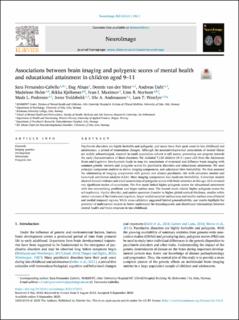| dc.contributor.author | Fernandez-Cabello, Sara | |
| dc.contributor.author | Alnæs, Dag | |
| dc.contributor.author | van der Meer, Dennis | |
| dc.contributor.author | Dahl, Andreas | |
| dc.contributor.author | Holm, Madelene Christin | |
| dc.contributor.author | Kjelkenes, Rikka | |
| dc.contributor.author | Maximov, Ivan | |
| dc.contributor.author | Norbom, Linn Christin Bonaventure | |
| dc.contributor.author | Pedersen, Mads Lund | |
| dc.contributor.author | Voldsbekk, Irene | |
| dc.contributor.author | Andreassen, Ole | |
| dc.contributor.author | Westlye, Lars Tjelta | |
| dc.date.accessioned | 2022-12-07T12:33:16Z | |
| dc.date.available | 2022-12-07T12:33:16Z | |
| dc.date.created | 2022-10-25T14:47:09Z | |
| dc.date.issued | 2022 | |
| dc.identifier.citation | NeuroImage. 2022, 263. | en_US |
| dc.identifier.issn | 1053-8119 | |
| dc.identifier.uri | https://hdl.handle.net/11250/3036356 | |
| dc.description.abstract | Psychiatric disorders are highly heritable and polygenic, and many have their peak onset in late childhood and adolescence, a period of tremendous changes. Although the neurodevelopmental antecedents of mental illness are widely acknowledged, research in youth population cohorts is still scarce, preventing our progress towards the early characterization of these disorders. We included 7,124 children (9–11 years old) from the Adolescent Brain and Cognitive Development Study to map the associations of structural and diffusion brain imaging with common genetic variants and polygenic scores for psychiatric disorders and educational attainment. We used principal component analysis to derive imaging components, and calculated their heritability. We then assessed the relationship of imaging components with genetic and clinical psychiatric risk with univariate models and Canonical correlation analysis (CCA). Most imaging components had moderate heritability. Univariate models showed limited evidence and small associations of polygenic scores with brain structure at this age. CCA revealed two significant modes of covariation. The first mode linked higher polygenic scores for educational attainment with less externalizing problems and larger surface area. The second mode related higher polygenic scores for schizophrenia, bipolar disorder, and autism spectrum disorder to higher global cortical thickness, smaller white matter volumes of the fornix and cingulum, larger medial occipital surface area and smaller surface area of lateral and medial temporal regions. While cross-validation suggested limited generalizability, our results highlight the potential of multivariate models to better understand the transdiagnostic and distributed relationships between mental health and brain structure in late childhood. | en_US |
| dc.description.sponsorship | The European Research Council under the European Union's Horizon 2020 research and Innovation program (ERC StG, Grant 802998), the European Union through the Horizon Europe - the Framework Programme for Research and Innovation (“environMENTAL”), the Research Council of Norway (223273, 273345, 276082, 298646, 300767), and the South-Eastern Norway Regional Health Authorities (2019101, 2019107, 2020086). Data used in the preparation of this article were obtained from the Adolescent Brain Cognitive DevelopmentSM (ABCD) Study (https://abcdstudy.org), held in the NIMH Data Archive (NDA). This is a multisite, longitudinal study designed to recruit more than 10,000 children age 9–10 and follow them over 10 years into early adulthood. The ABCD Study® is supported by the National Institutes of Health and additional federal partners under award numbers U01DA041048, U01DA050989, U01DA051016, U01DA041022, U01DA051018, U01DA051037, U01DA050987, U01DA041174, U01DA041106, U01DA041117, U01DA041028, U01DA041134, U01DA050988, U01DA051039, U01DA041156, U01DA041025, U01DA041120, U01DA051038, U01DA041148, U01DA041093, U01DA041089, U24DA041123, U24DA041147. A full list of supporters is available at https://abcdstudy.org/federal-partners.html. A listing of participating sites and a complete listing of the study investigators can be found at https://abcdstudy.org/consortium_members/. ABCD consortium investigators designed and implemented the study and/or provided data but did not necessarily participate in the analysis or writing of this report. This manuscript reflects the views of the authors and may not reflect the opinions or views of the NIH or ABCD consortium investigators. | en_US |
| dc.language.iso | eng | en_US |
| dc.rights | Navngivelse 4.0 Internasjonal | * |
| dc.rights.uri | http://creativecommons.org/licenses/by/4.0/deed.no | * |
| dc.subject | Imaging genetics | en_US |
| dc.subject | Development | en_US |
| dc.subject | Multimodal | en_US |
| dc.subject | Polygenic risk | en_US |
| dc.title | Associations between brain imaging and polygenic scores of mental health and educational attainment in children aged 9–11 | en_US |
| dc.title.alternative | Associations between brain imaging and polygenic scores of mental health and educational attainment in children aged 9–11 | en_US |
| dc.type | Peer reviewed | en_US |
| dc.type | Journal article | en_US |
| dc.description.version | publishedVersion | en_US |
| dc.source.volume | 263 | en_US |
| dc.source.journal | NeuroImage | en_US |
| dc.identifier.doi | 10.1016/j.neuroimage.2022.119611 | |
| dc.identifier.cristin | 2064903 | |
| dc.relation.project | EC/H2020/802998 | en_US |
| dc.relation.project | Norges forskningsråd: 223273, 273345, 276082, 298646, 300767 | en_US |
| dc.relation.project | South-Eastern Norway Regional Health Authorities: 2019101, 2019107, 2020086 | en_US |
| dc.source.articlenumber | 119611 | en_US |
| cristin.ispublished | true | |
| cristin.fulltext | original | |
| cristin.qualitycode | 2 | |

